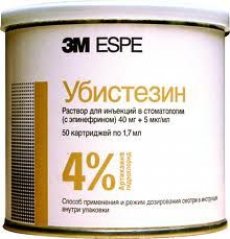Medical expert of the article
New publications
Preparations
Ubistezin
Last reviewed: 03.07.2025

All iLive content is medically reviewed or fact checked to ensure as much factual accuracy as possible.
We have strict sourcing guidelines and only link to reputable media sites, academic research institutions and, whenever possible, medically peer reviewed studies. Note that the numbers in parentheses ([1], [2], etc.) are clickable links to these studies.
If you feel that any of our content is inaccurate, out-of-date, or otherwise questionable, please select it and press Ctrl + Enter.

Ubistesin is an anesthetic for local use in dental practice.
Indications Ubistezin
Ubistesin is used for pain relief during dental treatment, tooth extraction and caries filling.
 [ 1 ]
[ 1 ]
Pharmacodynamics
Ubistesin contains Articaine. It acts already 2 minutes after administration. Allows for treatment and tooth extraction lasting up to 55 minutes. No significant increase in pressure is observed after an injection of Ubistesin.
Dosing and administration
When preparing for filling, Ubistezin is administered in a dosage of 0.5 - 1.7 ml into the gum on the vestibular side. When extracting a tooth, the highest dose is administered per tooth - 1.7 ml. Up to 7 mg of articaine per 1 kg of body weight (for adults) can be administered at a time. The anesthesia lasts for 50 minutes.
 [ 10 ]
[ 10 ]
Use Ubistezin during pregnancy
Ubistezin can be used during pregnancy and lactation. It can penetrate the placental barrier in minimal quantities, but this cannot harm the child. It is preferable to carry out dental treatment in the 2nd trimester of pregnancy.
Contraindications
Ubistesin is strictly contraindicated for use in patients with hypersensitivity to articaine, patients with bronchial asthma, glaucoma, porphyria, severe liver and kidney failure, hyperthyroidism. It is prescribed with caution in diabetes mellitus, arterial hypertension, in the elderly and children.
 [ 7 ]
[ 7 ]
Overdose
Overdose of Ubistesin is accompanied by dizziness, loss of consciousness, and heart rhythm disturbances. Free access to oxygen is required. To stop an overdose, artificial ventilation of the lungs is performed, barbiturates are administered, and in case of shock, an electrolyte solution, plasma substitutes, and albumins are administered.
 [ 11 ]
[ 11 ]
Storage conditions
At room temperature, in a dark place. Keep the drug out of reach of children.
Special instructions
If long-term surgical intervention on the face is required, sensitivity reactions are observed to many local anesthetics; if the patient is mentally unstable, general anesthesia or sedation (medicinal sleep) is used.
It is also possible to lubricate the tissues with an anesthetic. This method is well suited for treating small patients or when removing dental plaque. The drug is applied with a cotton swab. Electrophoresis or jet anesthesia, using an injector, an electromagnet and laser, and freezing are very rarely used.
Local complications of local anesthesia in dentistry are short-term. Thus, when using disposable needles, they very rarely, but can break. To prevent this, the needle is not inserted to its full length.
To avoid pain during the injection, the anesthetic is administered very slowly. There are also nerve injuries, which slightly reduce sensitivity for a month. The frequency of this complication is about 20%. Sometimes, a spasm of the masticatory muscles may occur. It is associated with trauma to the vessels by the needle. Tissue necrosis may also develop.
The advantages of local anesthesia in dentistry over general anesthesia are obvious: in most cases, local anesthesia is easily tolerated, and the toxicity of local anesthetics is minimal.
However, there are cases when general anesthesia is justified. This can be mask anesthesia, endotracheal or intravenous. For general anesthesia, a dental clinic must have a special permit. Most often, general anesthesia is used for dental implantation. Before general anesthesia, the patient undergoes an examination, as before an operation, doctors study his anamnesis in detail. Under general anesthesia, you can treat many diseased teeth at once and save time. General anesthesia is contraindicated in case of heart disease, stroke, asthma, diabetes, liver and kidney diseases with a significant decrease in their function, pregnancy.
When administering pain relief, caution should be exercised in patients with diabetes mellitus and a recent myocardial infarction.
Anesthesia reinforces the normal reaction to dental treatment. Dentistry and pain are incompatible concepts today. Therefore, fewer and fewer people are afraid of dental treatment. You can always choose an anesthetic that suits you. Toxic novocaine is no longer used. The patient does not experience stress and negative emotions when visiting the dentist, and the doctor calmly performs all manipulations. The success of the treatment is determined not only by how new the instruments and technologies are used, not only by the doctor's skills, but also by the psychological attitude of the patient. And it cannot be positive if the patient is afraid. This factor is especially important in dental surgeries, since a person who is even slightly sensitive to pain and calmly tolerates dental treatment without anesthesia will not want to remove teeth without anesthesia. Especially when it is necessary to install implants by implanting them into the bone. Most clinics use high-quality and safe imported drugs for anesthesia. They can be used by pregnant women, they do not contain adrenaline. Sedatives can also be used for calming. This is called premedication.
Shelf life
The shelf life of Ubistesin is 2 years. Do not use after the expiration date.
Attention!
To simplify the perception of information, this instruction for use of the drug "Ubistezin" translated and presented in a special form on the basis of the official instructions for medical use of the drug. Before use read the annotation that came directly to medicines.
Description provided for informational purposes and is not a guide to self-healing. The need for this drug, the purpose of the treatment regimen, methods and dose of the drug is determined solely by the attending physician. Self-medication is dangerous for your health.

